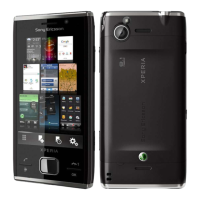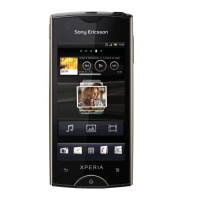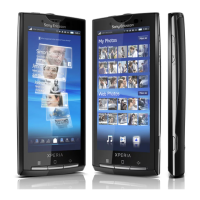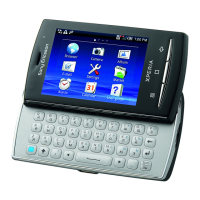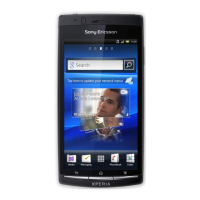Do you have a question about the Sony Ericsson Xperia PLAY and is the answer not in the manual?
A phone program that helps you perform a task. Examples include making calls, taking photos, and downloading more applications.
Instructions on how to remove and insert the battery cover and SIM card.
Steps to power on the phone, activate the screen, and unlock it.
How the screen locks automatically and how to unlock it manually.
Guide for initial phone setup, including basic functions and essential settings.
Signing up for and using online service accounts to integrate phone features.
Identifies and describes the various physical buttons and components of the phone.
Explains the function of the Back, Home, Menu, and Search keys on the phone.
Instructions on how to charge the phone using a power adapter or computer.
Details on interacting with the touch screen, including tapping, marking, and zooming.
How to navigate content by moving your finger up, down, or sideways on the screen.
Introduction to the phone's Home screen as a central hub for features and customization.
Explains the function of the light and proximity sensors.
Instructions on how to launch the PlayStation® Pocket application to play games.
How to navigate and interact within games, including pausing and resuming.
Describes the function of directional buttons, game-specific keys, and triggers.
How to make emergency calls, with or without a SIM card.
Steps for making, answering, declining, and managing calls.
How to set up and access voicemail service for missed calls.
Handling multiple calls simultaneously using call waiting features.
Initial steps for accessing the contacts application and adding new contacts.
Methods to import contacts, including synchronization, SIM card, and memory card.
How to access and view the list of contacts stored on the phone.
Creating, editing, and synchronizing contact details to avoid duplicates.
Sending and receiving SMS and MMS messages, including conversations.
Step-by-step guide for composing and sending new text or multimedia messages.
How to respond to received text or multimedia messages.
Process for sending a received message to another recipient.
Instructions for configuring email accounts, including corporate and Gmail.
How to create, send, receive, and manage email messages.
Adding an email sender's contact information to the phone's address book.
Overview of the main interface, showing status, tiles, and event filters.
How to add, remove, and use the Timescape™ widget on the Home screen.
Navigating through communication tiles and managing events within Timescape™.
Steps to access the Android Market application to browse and download apps.
Details on how purchases are handled, including Google Checkout.
Process for downloading free and paid applications from the market.
How to check what access an application requires on your phone.
Managing your schedule, creating events, and setting reminders.
Setting, deactivating, and managing alarm clock functions.
How to set up and manually sync your phone with Google accounts.
Setting up and managing corporate email, calendar, and contacts sync.
Using Sony Ericsson Sync to manage contacts and create backups online.
How to turn on Wi-Fi, connect to networks, and manage network status.
Manually adding Wi-Fi networks and configuring sleep policies.
Sharing phone media files with other devices over a Wi-Fi network.
Enabling USB tethering to share your phone's data with a computer.
Turning your phone into a Wi-Fi hotspot to share its data connection.
Explains the functions available in the web browser's toolbar.
How to navigate websites, search, and go to web pages.
How to bookmark web pages, edit, delete, and add shortcuts.
How to play audio content, browse tracks, and manage playback.
Creating, playing, and managing music playlists, including smart playlists.
Activating the camera, switching modes, and taking photos.
Adjusting focus, exposure, scene modes, picture size, quality, and color effects.
Recording videos, adjusting settings like white balance and flash mode.
Organizing photos and videos into albums and viewing their content.
Viewing, zooming, rotating, sharing, and deleting individual photos.
How to set a name for your phone to be identified by other Bluetooth devices.
Steps to connect your phone with other Bluetooth devices like headsets or car kits.
Sharing files such as photos, music, and contacts via Bluetooth.
Using a USB cable for file transfer, including MTP and Mass Storage modes.
Installing and using PC Companion for phone management and software updates.
Using the Media Go application for transferring and managing media files.
Activating GPS satellites for precise location tracking.
Enabling wireless network location services for approximate positioning.
Using Google Maps for navigation, traffic, and finding locations.
Information on finding your phone's unique IMEI number.
Setting up PIN locks for the SIM card to protect your subscription.
Configuring a screen lock pattern, PIN, or password for phone security.
Downloading and installing software updates directly to the phone.
Using PC Companion to update phone software via a computer.
Explains various status icons displayed on the phone's screen.
Explains icons that indicate new messages or ongoing activities.
How to use the Support application for guides, troubleshooting, and contact information.
Tips for resolving common phone issues like unresponsiveness or restart problems.
Procedures for resetting the phone to its original settings, with or without data loss.
| Processor | 1 GHz Scorpion |
|---|---|
| RAM | 512 MB |
| Selfie Camera | No |
| Stand-by | Up to 425 h (2G) / Up to 413 h (3G) |
| Talk time | Up to 8 h 25 min (2G) / Up to 6 h 25 min (3G) |
| Dimensions | 119 x 62 x 16 mm (4.69 x 2.44 x 0.63 in) |
| Weight | 175 g (6.17 oz) |
| Operating System | Android 2.3 (Gingerbread), upgradable to 4.0 (Ice Cream Sandwich) |
| Chipset | Qualcomm MSM8255 Snapdragon S2 |
| GPU | Adreno 205 |
| SIM | Mini-SIM |
| Protection | Scratch-resistant glass |
| Loudspeaker | Yes |
| 3.5mm jack | Yes |
| WLAN | Wi-Fi 802.11 b/g/n, hotspot |
| Bluetooth | 2.1, A2DP |
| GPS | Yes, with A-GPS |
| Radio | Stereo FM radio, RDS |
| USB | microUSB 2.0 |
| Sensors | Accelerometer, proximity, compass |
| Browser | HTML, Adobe Flash |
| Colors | Black, White |
| Display | 4.0 inches, 480 x 854 pixels |
| Storage | 400 MB, microSDHC up to 32 GB |
| Main Camera | 5 MP, autofocus, LED flash |
| Battery | Li-Ion 1500 mAh |
| SAR | 0.77 W/kg (body) |
